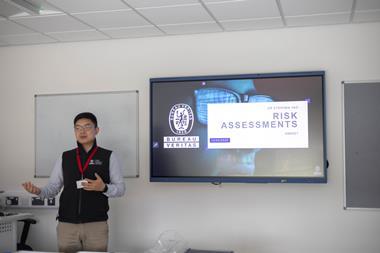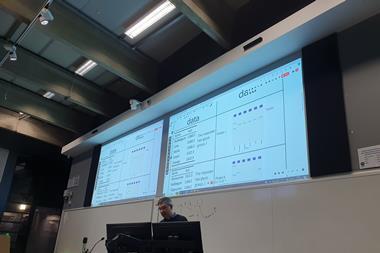Communication officers dedicate their careers to telling impactful stories
A few years ago, Julie Kiefer, director of science communications at University of Utah Health, experienced one of the most satisfying moments of her career. Kiefer was part of the team that produced One in a Million, a moving tale about a boy, Tyler, who had a debilitating disease that defied diagnosis.
As the film shows, University of Utah Health’s Penelope Program for Rare and Undiagnosed Diseases cracked Tyler’s case using whole genome sequencing and created a treatment regimen that considerably improved his health. ‘We were working with [Tyler’s family], and seeing how that research changed everything for them was very touching,’ says Kiefer.
The film was instrumental in the state of Utah’s introduction of a law mandating medical insurance to cover the costs of whole genome sequencing for diagnosing rare diseases in children in 2019. University of Utah Health also secured a $3.6 million (£2.8 million) donation because of the movie’s impact. ‘It helped me understand how making science accessible and helping people understand what science can do can make a lot of difference,’ says Kiefer.
Many individuals with a scientific background, such as Kiefer, have found their calling in communications. A career in the field can be fulfilling for science lovers with a knack for storytelling and people skills – if they are willing to embrace its evolving, fast-paced nature.
A natural fit for an important role
Organisations of all stripes – industrial, nonprofit, and academic – hire talented storytellers to bolster their branding and external communications. Communications officers are especially essential for universities with massive research enterprises, where they work across different mediums to weave scientific data into palatable narratives for the public’s understanding.
Some communications officers write press releases and long-form features about research and scientists for various university publications and press release services like EurekAlert and Newswise. Others may be more concerned with handling social media, designing graphics and creating multimedia content like podcasts and videos. At many organisations, communications staff help with fundraising decks and grant proposals too. As these specialists gain more experience and move on to leadership roles, they start to supervise teams and their work becomes more managerial. At this stage, they also engage with organisational leadership on a deeper level to devise a communications strategy for bolstering the institution’s image.
Science communicators are a crucial conduit between scientists and the wider world, explains Xuefei Huang, a professor of chemistry and biomedical engineering at Michigan State University, US. ‘We do tend to have the impression of scientists doing things in their ivory towers,’ Huang notes, emphasising the need for the public to understand the nature of discoveries that are taking place in labs – and how these impact their lives. Kiefer adds that science communication officers also play a role in dispelling misinformation by providing solid, evidence-based reports based on research and expert interviews. ‘A lot of research is funded by taxpayers. People deserve to know what their money is going towards,’ she adds.

While a science degree is not required to work as a communications specialist at a scientific organisation, many individuals working in the field possess a background in science – some even have a PhD. ‘Even in graduate school, I started suspecting that a career in academia was not the right fit for me,’ says Kiefer, who has a PhD in biochemistry. There, she started to look at other options such as writing and teaching, and took a science writing class. After her postdoc, Kiefer began a science writing job at a scientific journal. She followed that up with freelance science writing and later accepted a communications role at the University of Utah.
Lauren Quinn, however, landed in communications by accident. ‘I always had in mind that I would be a professor just like my adviser in graduate school,’ says Quinn. ‘I really looked up to her and thought her job seemed great.’ However, Quinn struggled to find a permanent faculty position. After her second postdoc, she tried her hand at scientific and technical editing. Eventually, she joined the College of Agricultural, Consumer and Environmental Sciences at the University of Illinois Urbana-Champaign, US, as a media communications specialist; she has since been promoted to assistant director of research communications.
A scientific background can undoubtedly be advantageous early on in a communications career. ‘Some of the science gets complicated, and I can read the original papers if I need to. Not everyone can do that,’ says Kiefer. Having been a researcher, she also understands how labs and funding work. ‘I find that part of my job is helping other communicators or even people in leadership understand some of these nuances so that they can have a better grasp of what’s possible and why things happen the way they do,’ she says.
Never a dull day
Communication officers juggle multiple tasks, such as chasing scientists, writing stories and engaging journalists, every day. ‘There is no typical day, which is part of the fun,’ says Kiefer, who leads communication efforts for five schools and colleges in the health sciences section of the University of Utah.
When a scientist wins a prestigious award or publishes a paper in a top-tier journal, ‘we just drop everything else on our plate and try to get the story out as soon as possible’, says Jake Stump, director of research communications at West Virginia University and a former journalist. ‘In some instances, I have flashbacks of working in a newspaper.’
Communication officers are also at the centre of efforts by research institutions to train scientists to be better communicators, especially when speaking to the media. ‘It’s something that I’m passionate about,’ says Lucky Tran, director of science communication and media relations at Columbia University Irving Medical Center, who has a PhD in biochemistry. ‘I know, personally, that unless you seek out those opportunities, those are not a key part of a scientist’s training.’
There is a lot of room for enterprise and creativity
At the beginning of the Covid-19 pandemic, Tran witnessed the impact that this training has. ‘One of the big challenges that we had was that there were a lot of scientists who had never spoken to the media much before and suddenly they were thrust in the world spotlight,’ says Tran. His team had to train these researchers to talk to the media quickly. ‘When information is fast and you don’t have the full picture yet, it can be tricky to convey quick, accurate messages that the public understands and everyone is interested in,’ he says.
Ankita Rathore, program manager of the science communication vertical at IndiaBioscience, a science facilitation organisation that primarily mentors life science researchers, loves the freedom that her role offers. ‘There is a lot of room for enterprise and creativity,’ she says.
Rathore’s regular duties involve managing the website content and interns, handling social media channels and conducting workshops. Last year, during a conversation with her colleagues, Rathore pitched the idea of a science writing competition. Now it’s a reality, and she’s leading the competition programme this year.
Navigating challenges and finding success
Communication officers spend a sizeable amount of their work week interacting with scientists – which can be both fun and challenging. For example, Stump says when a study isn’t newsworthy or doesn’t fit into one of the university’s priority research areas, his team decides not to pursue it. ‘One of the challenging things is getting back to your researcher and saying, “This isn’t a good fit right now”,’ says Stump. In such cases he will help researchers find other avenues for publicity, such as their college website or newsletter.
Researchers are also notoriously busy. Communicators need to build relationships with their organisation’s scientists and impress upon them the importance of publicising their research. ‘I find the best way is to see people face to face still,’ says Kiefer. ‘When big symposia are happening on campus, we try to be there.’ Quinn, on the other hand, finds that some scientists contact her repeatedly while others are harder to track down: ‘It’s hard to balance the representation of who we’re talking about.’
Institutes will likely always need communicators
James Devitt, managing director of public affairs at New York University, says that communicators need sharp analytical skills in a fast-paced world where the news cycle revolves quickly. ‘It’s important to recognise what’s relevant to a piece of scholarship or science that’s going to matter to a general audience,’ says Devitt – which might not always match what matters to a scientist. For that reason, Devitt says it’s also essential to convey to faculty why certain findings are highlighted – and others not – in media.
Moreover, communicators often have to step up and take on the role of a science educator when dealing with the general assignment press, whose members often lack the training to decode complex science topics.
Job opportunities in communications vary across industries and may fluctuate depending on a country’s economic situation. But there are plenty of domains, such as pharma and biotech, that seek communicators. Kiefer says job booms come and go, but institutes will likely always need communicators. Stump also anticipates more communications jobs in the future.
Quinn is glad she jumped from research to communications. ‘It’s a very cushy job and existence. I do not have to think about it after I leave work. I don’t have to worry about supporting graduate students and lab staff and bringing grants in so they can continue to work,’ she says.
She is also grateful to learn about a variety of topics instead of focusing on a niche area: ‘I like to think I’m helping the public come along with me in that journey of building knowledge and getting curious and interested in the world – and that’s impactful.’
How to get into science communication
Start where you are: Share the latest research in your area on social media platforms. This will also help you connect with other researchers and build a community. Look for science writing or similar courses at your institution.
Test the waters: You might find an internship opportunity at your university’s communications office. If you’re in the US, you can apply for the AAAS Mass Media Science & Engineering Fellowship, which will provide you with a 10-week opportunity to work in a newsroom – valuable experience whether you want to go into journalism or communications. The knowledge of newsroom culture and news trends will be helpful once you start working full-time.
Write, write, write: Pick up freelance writing work with science magazines. You can also publish commentary pieces and essays on a blog.
Do your research: Strike up friendships with the communicators at your institution or set up informational interviews to find out more about what they do day-to-day. Look through your institution’s alumni networks for industry contacts. Set up LinkedIn Alerts for communications jobs to see the types of roles that exist, their salary ranges, and the geographical hubs for these kinds of jobs. Join professional societies of writers that are active in your area.

















No comments yet